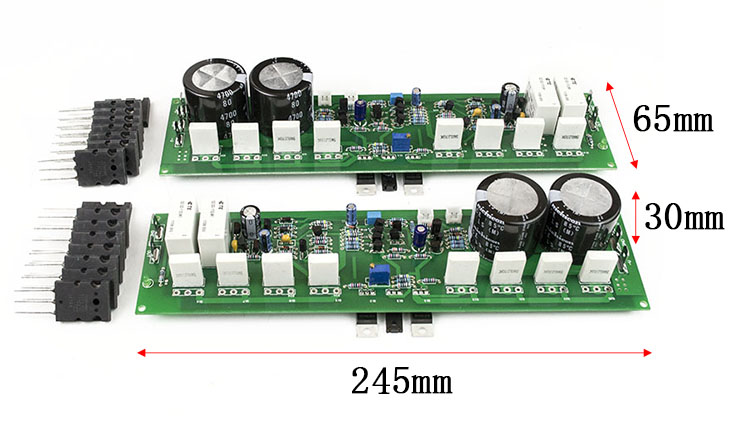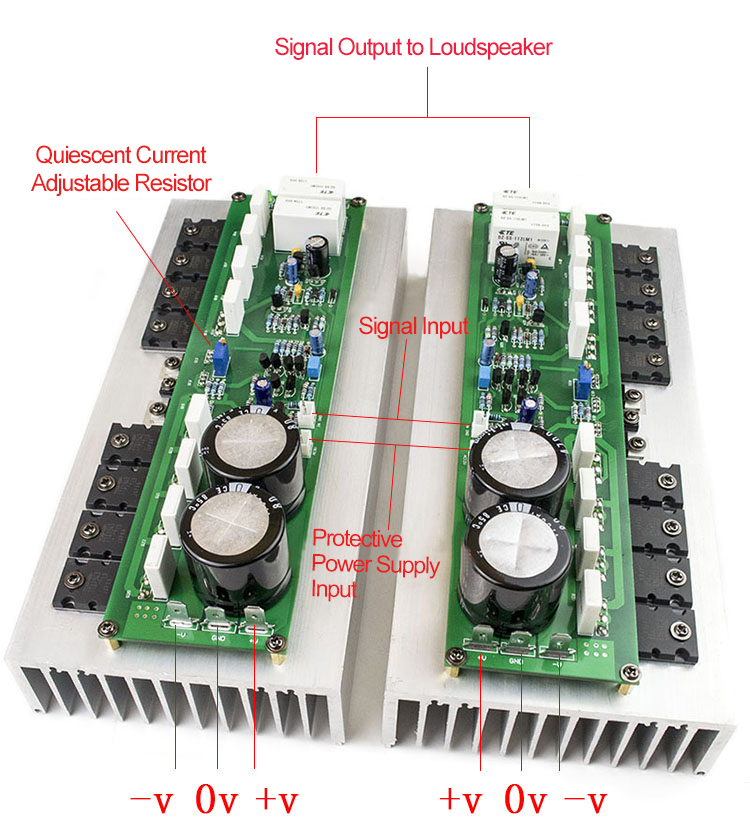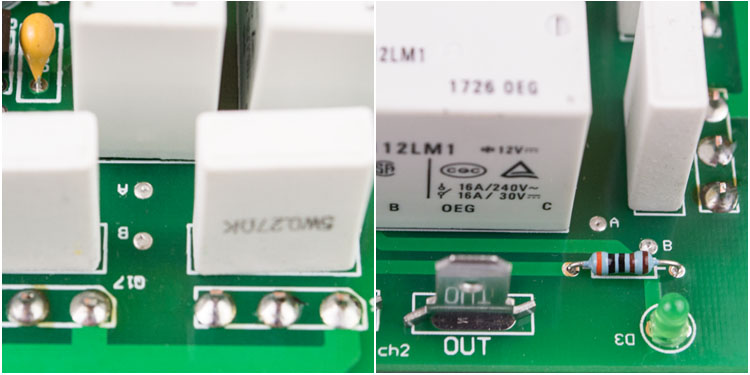
Tags: Power Amplifier Board
| Quantity | 3+ units | 10+ units | 30+ units | 50+ units | More |
|---|---|---|---|---|---|
| Price /Unit | $57.31 | $56.14 | $54.39 | $52.05 | Contact US |
 DAM-100 TPA3221 Power Amplifier Board 100W+100W Low Distortion HiFi Class D Amplifier Module
$16.52
DAM-100 TPA3221 Power Amplifier Board 100W+100W Low Distortion HiFi Class D Amplifier Module
$16.52
 SAMP-300 Dual Core TPA3255 HiFi 2-Channel Power Amplifier Board 600W+600W Automatic Energy-saving Version
$37.93
SAMP-300 Dual Core TPA3255 HiFi 2-Channel Power Amplifier Board 600W+600W Automatic Energy-saving Version
$37.93
 Transaudio D9PRO 150W/8Ω 300W/4Ω Power Amplifier Power Amp (Black) Based on Circuit for DarTZeel
$1,258.56
Transaudio D9PRO 150W/8Ω 300W/4Ω Power Amplifier Power Amp (Black) Based on Circuit for DarTZeel
$1,258.56
PR-800 HiFi Power Amplifier Class A Amplifier Class AB Amp Board Standard Version without Heat Sink
Description:
PR-800 is specially designed for large floor speakers and stage audio. Power amplifier boards adopt dual-channel separation mirror symmetry design, which can effectively avoid signal crosstalk between the two channels, making the sound more pure and clearer. The higher the power supply voltage, the greater the output power. The lower the speaker impedance, the greater the relative output power and the greater the output current of the power amplifier board. When the output current of the power tube fails to meet the requirements, the output power will be greatly reduced, and there is even a possibility of burning. Therefore, we designed a total of 8 parallel outputs of 4 pairs of high power tubes to make the output current sufficient and the bass more The fullness is heavy and has a texture! In order to ensure the superiority of the PR-800 power amplifier board, this board uses all new original components, you can use it with confidence.
Configurations:
- Version: Standard Version
- Power Tube: NJW0302 NJW0281 for ON.
- Capacitors: 1800UF80V/10
- Heat Sink: without
Main Parameters of Power Amplifier Board:
- Power supply voltage: DC ±20V to ±100V. The output of transformer is AC voltage. The AC voltage needs to be input to the power amplifier board after rectification and filtering. Speaker protection power supply AC9V-15V (AC single voltage), the transformer output is directly input.
- Effective output power: 500W/8Ω (±95V power supply) 1000W/4Ω (±95V power supply) 1000W/2Ω (±65V power supply). It is recommended not to exceed ±65V at 2Ω load. The output power of the power supply is basically determined by the power supply voltage and the impedance of speaker. The lower the voltage, the lower the power.
- Maximum Class A power: 100W (effective value) ±45V power supply, load 8Ω, total static current 2.5A
- Total harmonic distortion: <0.01 10W/8Ω
- Frequency response: 10Hz-160KHz (-3dB)
- Conversion rate: 25V/uS
- SNR: >95dB
- Gain: 40 times
- PCB board size: 245 × 65 x 30mm
More Details:
- Boards adopt Taiwan high-precision five-color ring copper pin resistors with 1% error, high accuracy, small temperature drift, low current noise and excellent performance.
- The sound performance of power tubes is comprehensively balanced, with a wide sound field, strength and thickness, and high frequency transparency.
- Loudspeaker protection also uses two US-imported relays in parallel to output, further reducing the internal resistance of the output and increasing the carrying capacity of relay, which is more durable.
Package Included:
- 1 x Set of Power Amplifier Boards
Note:
- In order to meet the continuous improvement of sound of HiFi fans, the power tube supporting this power amplifier board is audio pair tube for ON. If you need to use 1943 5200 for Toshiba in this version, please contact us.
- The brand of capacitors equipped in the standard version is uncertain, depending on the availability. Please make sure that you don't mind before purchasing.
- Driving tube MJE15032/33 should be added with insulating sheet and insulating rubber particles, and temperature compensation D669 should also be fixed with your heat sink. Q16-Q19 is installed with N-type tube NJW0281, Q20-Q23 is installed with P-type tube NJW0302.
- Heat sink is not included. 
Attention: Boards without heat sink is to facilitate users to install power tube according to the actual situation. Power tube is not installed by default. There are many tubes to be installed. After installation, please check whether it is installed. Power tube is easily damaged if it is not installed properly. If you do not have the conditions to open holes, it is recommended to buy a product with a heat sink. When you buy the version with heat sink, power tube will be installed and shipped.
Wiring Diagram & Debugging Instructions:
Main power supply is DC ± dual voltage. AC voltage needs to be input after rectification, and loudspeaker protection power supply input is AC voltage, which can be directly input by AC voltage.
No need to adjust midpoint voltage, and the DC voltage at signal output terminal is measured. DC voltage is generally normal at tens of mV.
Static current test: measure the DC voltage between the third pin of power tube and output terminal, and then convert it into current according to Ohm's law, for example, the voltage at the two points is 22mv, the non-inductive resistance is 0.22Ω, and the conversion formula is: 4x22mv÷ 0.22Ω=400ma, the total quiescent current is 400ma.
Notes on Installation & Commissioning:
1. The boards needs DC voltage power supply. They have filter capacitors, but no rectifier bridge. You can add a rectifier bridge or power supply board.
2. Boards are not equipped with heat sink for easy installation, and power tube is not welded. Users can weld power tube to meet their needs. Power tube can be installed on the back, so that it can save a lot of space when installed, and is suitable for a sufficiently high heat sink. If your heat sink is not high enough, power tube needs to be erected and installed on it.
3. There are two types of power tube, each channel has 4 pairs of power tube power amplifier board marked with specific models, pay attention not to install the wrong tube. The temperature compensation tube D669 should also be fixed to your radiator like power tube.
4. The installation of power tube requires strong hands-on ability. If there is no condition, it is recommended to equip with a special heat sink. If power tube is not installed properly, the tube is easily overheated and burned.
5. Capacitors used in boards has a withstand voltage of only 80V, and power supply voltage cannot exceed DC ±80V (for an AC voltage of 57V). If you need to use a higher voltage, you need to change capacitors with higher voltage.
6. The boards are a dual mono design. 2-channel power supply needs to be completely independent. It is not recommended that the 2-channel power supply or ground be shared. For the two-channel shared power supply, it is easy to cause hum or even instability.